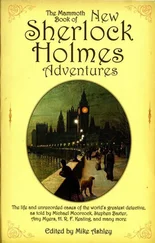It was the panel that Yeoman had caught his fingers on, Mandeville saw, that he had said had bitten him. Parry had ribbed him mercilessly about it after binding his fingers, particularly when they found a torn string of skin caught in the lion’s mouth on the front of the panel. Dried blood was still crusted around its wooden teeth, dribbling down its chin and the rest of the panel in long, clotted strings.
Mandeville went back across the bar, flicking the torch around him as he went. Nothing. The girl had either gone further down the corridor, which he doubted as all the doors along it were locked except the very furthest, an exit to the fire stairs which squealed violently as it opened, or she had gone higher, to the second or third floor.
This was becoming annoying and complicated, and he would have to wake the other members of the Crew to help look for her.
As he reached the doorway, a noise came from behind him, a throaty, hoarse growl that stretched for seconds, and as he turned a dark shape came across the floor at him with a rapid, ferocious clatter.
Yeoman woke to find himself staring a warped wooden lion, blood flaking from its mouth in dark red drifts.
“It fell off the wall last night,” said Mandeville by way of explanation, “and nearly fucking gave me a heart attack. Maybe it’s got it in for us, what do you think? By the way, we’ve got an intruder, or at least, we did last night. Somewhere there’s a place to get in that we don’t know about, and first job today is to find it.”
It was colder that morning, and even dressed and with coffee and breakfast (cooked on the tiny camping stove) inside him, Yeoman shivered.
Outside the temperature was even lower, and as he walked the perimeter of the Grand smoking and looking for potential entry points, Yeoman tried to see the hotel as it might be in the future.
Architecturally, it was generally sound, so most of his work was done. He had some suggestions to make about the use of the lower floor rooms and about how some of the walls could be altered to make a more open space, but he knew that his role here had become one of support rather than leading. This job would bear Parry’s and, especially, Mandeville’s stamp rather than his own. He was fine with that, knowing that he would get equal credit anyway; Mandeville was strict about the fact that the Save Our Shit Crew were partners. Whatever fortune they shared, they shared in equal proportion.
There were no obvious entry points that Yeoman could see, and Parry told the same story from his search of the hotel’s insides. Mandeville himself didn’t look convinced, but didn’t argue, telling them instead to keep an eye out and to be alert. He was distracted, Yeoman knew, because once the search was done they could reveal the third floor’s secrets.
“The rooms are intact,” said Parry, unnecessarily. They had discussed this already, but he looked as nervous as Mandeville. “Whatever other idiocies the various owners inflicted on this places, they knew that keeping the suites on the third floor as close to their original state was important.
“The carpets have gone, of course, but we have the patterns for them in Priest’s records so they can be recreated, the wall hangings likewise. The taps, the window latches, the door handles, the bath feet and the fittings for the showers and toilets are all original except for one or two replaced items, but they can be easily sorted out.
“The carpet in the corridor has been replaced as well, and we don’t have a pattern for it, but we do have photographs and descriptions, so recreating it might be complex but it’s achievable. The theme is all there, waiting for the new owners to agree it, but it only works if the art itself still exists. It’s the thing that ties it together, gives the guests the language to understand what their rooms were telling them.”
Parry spoke like this when he got excited, Yeoman remembered, talking about art’s “language”, its “voice”, its “pulse” and its “heartbeat”.
“If it’s survived, we can recommend that the top floor is recreated in its entirety, that the new guests can be as surrounded by Gravette’s and Priest’s beliefs in God and nature as interchangeable beauties as their predecessors were. If it’s damaged, irreparable, then it doesn’t matter, the heart will be gone.”
As he spoke, Parry was levering the first of the cheap panels from wall. The screws came unwillingly from the wood with a noise like cats in the darkness. The panel, a composite of some sort, bowed out damply, splintering apart as Mandeville took hold of it.
“Shit,” said Mandeville quietly; the panel was so damp his fingers were leaving denting grooves in it, “they didn’t even use decent fucking wood. In this atmosphere. ” He voiced tailed off, miserable in the silence, as Parry removed the last screw and then the first of Gravette’s pieces was revealed.
It was a picture of a woman standing on the edge of a great sea. She was naked, her back to the canvas, her buttocks and shoulders clearly delineated by Gravette’s loving brush, her hair long down her back. Although there was nothing obvious, something in the way the brushstrokes, still visible in the thick paint, formed the sea and the sky hinted at things below the surface or just beyond vision, things that swirled and glided and floated.
Around the woman, by her feet on the sand, pieces of machinery lay glittering with oily life, cogs and levers and panelling and rivets forming a platform that looked like a vast mechanical hand upon whose edge the woman was precariously balanced.
The picture was, despite the damp affecting the panel covering it, in remarkably good condition. Apart from a small amount of blackly-furred moss just creeping along a part of the picture’s bottom edge, there was no obvious damage; the colours were bright, vibrant, the detailing astonishing. The woman’s muscles were distinct beneath her skin, her outstretched hands seeming to grasp at the whole of the scene beyond her.
“Beautiful,” breathed Mandeville, and Parry simply nodded.
Yeoman, less moved by the artwork but still appreciating the skill that had rendered the picture, said, “Is that Priest then? Nice arse.”
“It’s not Priest,” said Parry, ignoring the obvious provocation, “it’s woman , an archetype, a feminine ideal.”
“It’s an ideal arse,” agreed Yeoman, grinning at Parry.
Parry, shaking his head disgustedly but unable to prevent himself grinning back, said, “Let’s do the others.”
All fourteen pictures were in similar condition, having survived far better than Mandeville could have hoped. Collectively, the pictures were called The Stations of the Way , and if you followed their story, up one side of the corridor and then back down the other, right side along and left back, they told the story of Gravette and Priest’s beliefs as surely as any bible or philosophical tract.
Across the pictures, the woman waded into the ocean, leaving the machinery behind, swimming and dancing with vast and unnameable creatures under the green surface before being lifted out and hauled into the sky by flying versions of the same creatures.
The figure of the woman became smaller and smaller in the pictures, surrounded by winged and tentacled and finned creatures with fierce and unforgiving faces, but who robed her and held her as, in the distance, small and insignificant, machines ploughed the surface of the water and left tiny trails across the sky.
Despite her size, the woman remained the absolute focal point in each picture, and every one of the creatures in the picture laid their full attention upon her.
The Inhabitants of the Grand; The End of the Crew
Although they hadn’t finished the job of assessing the Grand, Mandeville went out for champagne, and the three men drank it that night from plastic cups after they had finished another takeaway meal.
Читать дальше










